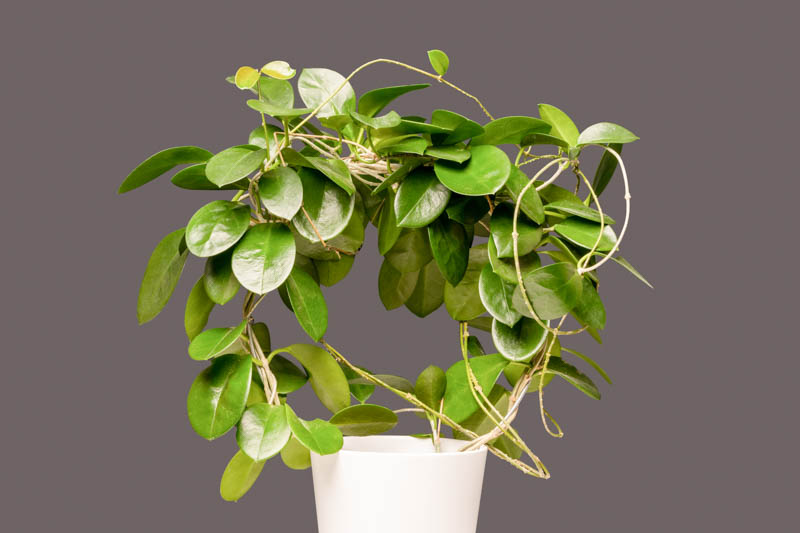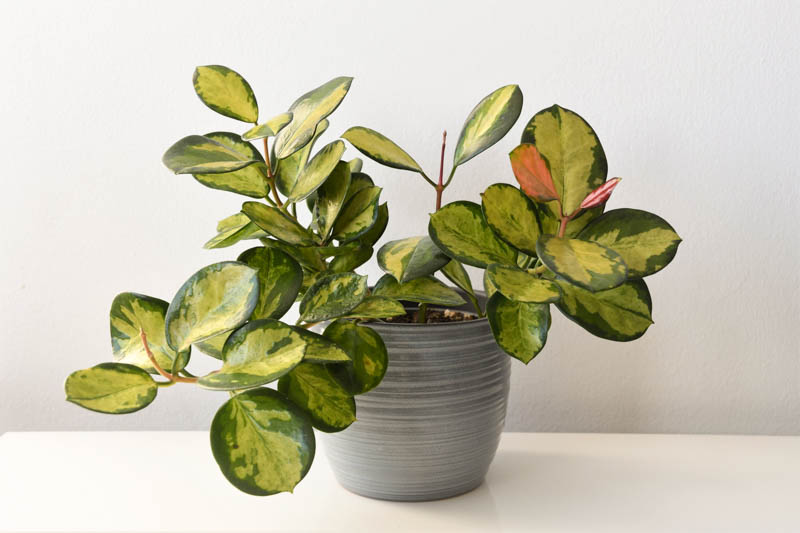Waxvine, Porcelain Flower, Honey Plant, Common Waxflower, New South Wales Wax Flower
Hoya australis, commonly known as the Waxvine or Common Waxflower, is a vigorous and lush member of the Hoya family. It is celebrated for its fragrant blooms and glossy foliage.
Hoya australis features vibrant green, ovate leaves that are slightly succulent, making it an excellent plant for retaining moisture. Its vines are sturdy and can climb or trail, depending on the support provided, offering a versatile display in hanging baskets or as a climbing houseplant.
Native: This species is native to Australia and parts of East Asia, thriving in tropical and subtropical climates. It’s found in a range of habitats, from coastal regions to forests, showcasing its adaptability. It belongs to the dogbane family (Apocynaceae), along with plumeria, periwinkle, mandevilla, or oleander.
Plant Type and Habit: An evergreen climbing vine, Hoya australis is renowned for its ability to grow rapidly under the right conditions, either trailing or climbing, with leaves arranged oppositely along its stems.
Size: In its natural habitat, it can reach 13 to 33 feet (4 to 10 meters), but as a houseplant, it grows much smaller.
Hoya Flower: The plant produces clusters of star-shaped, pinkish-white flowers that emit a sweet, intoxicating fragrance, especially in the evening. Flowering occurs in late summer to fall.
Fruit: Like other Hoyas, it can produce seed pods after successful pollination, though this is less common indoors.
Foliage: The glossy, thick, oval-shaped leaves are a highlight. New growth often displays a beautiful, deep red hue before maturing to deep green.
Hardiness: If grown outdoors, it’s hardy in USDA zones 10-11. Indoors, it adapts well to standard home environments.
Uses: Ideal as a houseplant or in a greenhouse where its trailing vines and fragrant blooms can be admired. It’s also used in outdoor settings in warm climates.
Toxicity: Hoya australis is non-toxic to pets and humans, making it a safe addition to households with animals and children.
Invasiveness: It is not considered invasive, as it’s mostly grown in controlled indoor or greenhouse environments.
Benefits: Beyond its ornamental appeal, Hoya australis is believed to purify the air, removing toxins and improving indoor air quality.

Growing and caring for Hoya australis, a lush and fragrant addition to any indoor garden, is relatively straightforward.
Light: Hoya australis thrives in bright, indirect light. It can tolerate some direct morning or late afternoon sun but avoid prolonged exposure to harsh midday sunlight, which can scorch the leaves.
Soil: Use a well-draining potting mix, ideally one that includes perlite, orchid bark, or other materials to ensure good aeration and drainage. A mix designed for succulents or cacti can also work well.
Water: Water when the top inch of soil feels dry to the touch. Hoya australis prefers to be kept on the drier side rather than waterlogged. Reduce watering in the winter months when growth slows.
Temperature and Humidity: It prefers warm temperatures, ideally between 60°F to 85°F (15°C to 29°C). Protect it from drafts and sudden temperature fluctuations, which can stress the plant. Hoya australis enjoys high humidity levels but can adapt to average household humidity. For increased humidity, use a pebble tray filled with water, group plants together, or use a humidifier.
Fertilization: Feed with a balanced, water-soluble fertilizer diluted to half strength every 4 to 6 weeks during the growing season (spring through summer). Do not fertilize in the winter.
Pruning: Pruning is not necessary for health but can be done to shape the plant or encourage bushier growth. Avoid pruning off the long tendrils where flowers form, as Hoya australis will rebloom from the same spurs.
Repotting: Repot every 2 to 3 years or when the plant becomes root-bound. Choose a pot only slightly larger than the previous one to avoid overwatering issues.

Hoya australis ‘Lisa’
Propagating Hoya australis is a straightforward process that can help you multiply your collection or share with friends. Stem cuttings are the most effective method for propagation.
Select a Stem: Choose a healthy stem with at least 2-3 nodes (points where leaves emerge) and several leaves. The stem should be free of pests and diseases.
Cut the Stem: Using your clean scissors or pruning shears, cut the selected stem just below a node. The cutting should be about 4-6 inches long.
Prepare the Cutting: Remove the leaves from the bottom node to ensure it can be inserted into the soil without leaves being buried. You can apply a rooting hormone to the cut end, but it’s not strictly necessary for hoyas.
Plant the Cutting: Fill a small pot with your well-draining potting mix. Make a small hole in the center of the soil and insert the cut end of your stem cutting. Firm the soil around the stem to support it.
Water Gently: Water the soil lightly, just enough to dampen it without making it soggy.
Create a Humid Environment: To help maintain humidity, you can cover the pot with a plastic bag or place it in a propagator. Ensure to open it occasionally to let air in and prevent mold growth.
Place in Indirect Light: Position your cutting in a warm spot with bright, indirect light. Avoid direct sunlight, which can scorch the young cutting.
Wait for Roots to Develop: Roots typically begin to form in 4-8 weeks. You can check for resistance by gently tugging on the cutting. If it feels anchored, roots have likely formed.
Care for Your New Plant: Once the cutting has established a good root system, you can treat it as you would a mature Hoya australis. Continue to provide bright, indirect light, allow the soil to dry out slightly between waterings, and enjoy the growth of your new plant!
Hoya australis is generally resilient, but like all plants, it may encounter pests and diseases.
Mealybugs: Look for white, cottony masses on stems and undersides of leaves. Remove with alcohol-dipped cotton swabs or apply insecticidal soap.
Scale insects: Hard, dome-shaped pests that attach firmly to stems and leaves, feeding on sap. Their presence can lead to yellowing leaves, stunted growth, and a decline in plant health.
Spider mites: Cause yellowing leaves and fine webs. Increase humidity and treat with miticide or insecticidal soap.
Root rot: Caused by overwatering and poor drainage. Ensure well-draining soil and allow the topsoil to dry out between waterings.
Yellowing Leaves: Can indicate overwatering, underwatering, or nutrient deficiencies. Adjust your watering routine and consider a balanced fertilizer.
Lack of Flowering: Insufficient light is a common reason. Hoya australis needs bright, indirect sunlight to bloom. Consider moving your plant to a brighter location.
Leggy Growth: This often results from too little light. Ensure your plant receives adequate indirect sunlight to encourage compact growth.
Hoya australis is not considered rare. It’s a relatively common species among Hoya collectors and enthusiasts, widely available in nurseries and online plant shops. Its popularity stems from its beautiful foliage and fragrant flowers, making it a sought-after species but not difficult to find.
Hoya australis can be both hanging and climbing. In its natural habitat, it tends to climb on trees and other structures using its aerial roots. As a houseplant, it can be trained to climb on trellises or allowed to hang gracefully from baskets, making it a versatile choice for different indoor setups.
Hoya australis thrives in bright, indirect sunlight. It can tolerate some direct morning or late afternoon sun, but prolonged exposure to intense direct sunlight can scorch its leaves. A spot that receives filtered sunlight for most of the day is ideal. If natural light is limited, it can also adapt to grow lights.
While not strictly necessary, providing a trellis or some form of support can encourage Hoya australis to display its climbing habit, leading to a more visually appealing plant. If you prefer, you can let it trail from a hanging basket without support. Whether to use a trellis depends on your aesthetic preference and how you wish to display the plant in your space.
| Hardiness |
10 - 11 |
|---|---|
| Plant Type | Houseplants, Climbers |
| Plant Family | Apocynaceae |
| Genus | Hoya |
| Exposure | Partial Sun |
| Season of Interest |
Spring (Early, Mid, Late) Summer (Early, Mid, Late) Fall Winter |
| Height |
13' - 33' (4m - 10.1m) |
| Maintenance | Low |
| Water Needs | Average |
| Soil Type | Loam, Sand |
| Soil pH | Acid, Alkaline, Neutral |
| Soil Drainage | Well-Drained |
| Characteristics | Showy, Evergreen, Fragrant |
| Native Plants | Australia |
| Garden Uses | Hanging Baskets, Patio And Containers |
| Garden Styles | Mediterranean Garden |
| Hardiness |
10 - 11 |
|---|---|
| Plant Type | Houseplants, Climbers |
| Plant Family | Apocynaceae |
| Genus | Hoya |
| Exposure | Partial Sun |
| Season of Interest |
Spring (Early, Mid, Late) Summer (Early, Mid, Late) Fall Winter |
| Height |
13' - 33' (4m - 10.1m) |
| Maintenance | Low |
| Water Needs | Average |
| Soil Type | Loam, Sand |
| Soil pH | Acid, Alkaline, Neutral |
| Soil Drainage | Well-Drained |
| Characteristics | Showy, Evergreen, Fragrant |
| Native Plants | Australia |
| Garden Uses | Hanging Baskets, Patio And Containers |
| Garden Styles | Mediterranean Garden |
How many Hoya australis (Waxvine) do I need for my garden?
| Plant | Quantity | |
|---|---|---|
| Hoya australis (Waxvine) | N/A | Buy Plants |
Create a membership account to save your garden designs and to view them on any device.
Becoming a contributing member of Gardenia is easy and can be done in just a few minutes. If you provide us with your name, email address and the payment of a modest $25 annual membership fee, you will become a full member, enabling you to design and save up to 25 of your garden design ideas.
Join now and start creating your dream garden!
Create a membership account to save your garden designs and to view them on any device.
Becoming a contributing member of Gardenia is easy and can be done in just a few minutes. If you provide us with your name, email address and the payment of a modest $25 annual membership fee, you will become a full member, enabling you to design and save up to 25 of your garden design ideas.
Join now and start creating your dream garden!